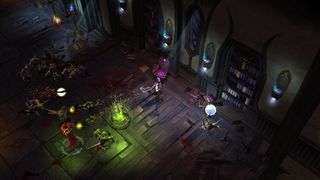Ruin hands-on preview - assassination invasion
Build your own headquarters and violate those of your enemies
As the wait for Diablo III stretches out to an agonizing length, more and more games are seeking to fill the gap. Ruin is a console take on the dungeon-crawler, calling itself a “social action-RPG.” It features a nifty bit of tech: you can play it either on your PS3 or your PS Vita, with your save game transferring between the systems, so you can play on your big TV at home and then head out into the world while still continuing your progress on Sony’s upcoming portable system. While the game may not heft graphics to rival a high-budget AAA title, it still serves to show the PS Vita’s graphical prowess since you’re playing the exact same game as on the PS3. Either way, the game looks plenty fine with its colorful, slightly cartoonish visuals.

While Ruin follows the standard core of explore, slaughter, loot, its gameplay twist is its Lairs. Each player owns a Lair, which they can decorate, upgrade, and populate with monsters, in essence creating a “home” dungeon. Beyond the regular story campaign where you ravage the countryside, you can invade other players’ Lairs for a chance at Fame and XP. Players don’t actively defend their Lairs – they merely set up the defenses, which include customizing monsters’ abilities down to elemental attacks and whatnot, but there’s an asynchronous aspect where if another player gets ready to invade your Lair, you’ll get a notice so that you can counterattack his Lair, if only to let him know you won’t take that crap sitting down. Neither player loses anything during these invasions, but each gains more XP depending on if the invader gets through the Lair or not.
Loot gained throughout the campaign can be used to decorate your Lair, which means a knowledgeable player who invades a Lair can tell by the accoutrements if the Lair owner is a badass. Invading Lairs also grants Fame, which is important because in the campaign you’ll come across NPCs who will only let you into side-mission areas if your Fame is high enough. The matchmaking system is designed so you’ll play against many of the same players throughout your time from low level to high level, creating a sense of community and friendly rivalry.
Last time we saw the game we got to see the standard warrior melee class, and we played around with him a bit again – the melee attacks have surprising heft and meatiness to them, delivering combat that really feels like you’re pounding on physical enemies. More interestingly, we also got to play the assassin character (there’s also a wizard, which we didn’t play yet), and suddenly the game turns almost into a shooter. The assassin’s base attack is a knife throw, with bombs as a secondary. So the game feels very different depending on your class – instead of charging into enemies and flailing wildly, we could lock on, circle-strafe, and pepper foes from afar. The Assassin also has a crazy teleport attack and a spray of homing projectiles to round things out.

Ruin definitely brings some strong, unique aspects to the well-trod dungeon-crawler template, and with a controller in hand, as opposed to a mouse and keyboard, it’s snappy and responsive, with a lot of dodging and sticking-and-moving involved. It inhabits an interesting space on the forefront of gaming technology: trans-platform, socially connected, and user-generated. If the wait for Diablo III (or Torchlight 2) is killing you, keep an eye on this one.
Sign up to the GamesRadar+ Newsletter
Weekly digests, tales from the communities you love, and more
Most Popular



